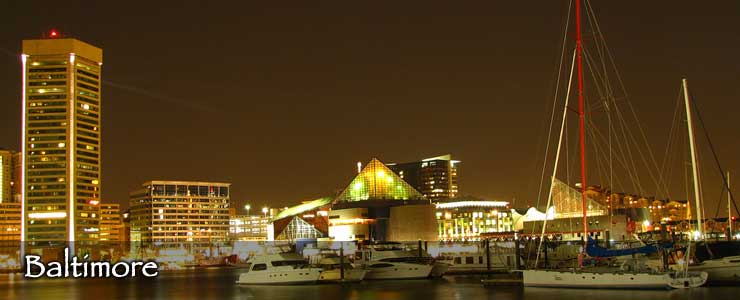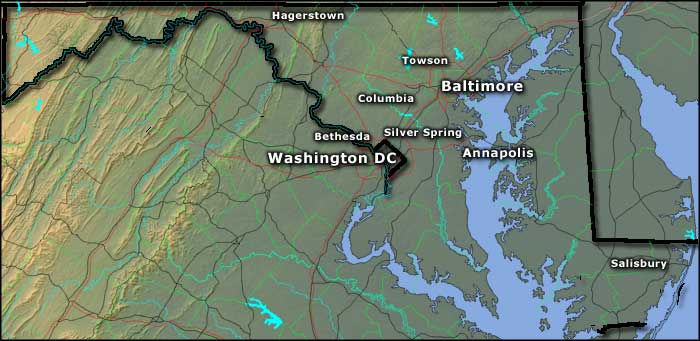Maryland - The Old Line State

The charter for the Province of Maryland was granted to Cæceilius Calvert, 2nd Lord of Baltimore, by Charles I in 1632. It was 1634 before Lord Baltimore sent the first settlers over. The first settlers were Protestants, although the original impetus for founding the colony was to provide a safe haven for Catholics in the American Colonies. Shortly, though, Maryland became one of the very few places in the British Empire where Catholic citizens were able to hold the highest political offices. In those days, Maryland was also a primary destination for the tens of thousands of British convicts the Crown was sending across the pond (this stopped after the American Revolution, then the convicts started being shipped to Australia).
In those early days, Delaware was part of Maryland. The granting of Pennsylvania to William Penn in 1680 caused a huge problem with Maryland when the Penn family took the stand that their common border was in the wrong place (too far north). Charles II tried to reach a compromise between the two groups in 1682 but then he gave Delaware to the Penn family and that caused more problems. This developed into a shooting war in the 1730's which was finally ended by George II in 1738. However, no final agreement was reached (and signed by both parties) until 1760.
Maryland was also the scene of religious upheaval for many years. In spite of earlier declarations of religious tolerance, the Anglicans, Puritans and Catholics just couldn't get along. When Virginia made Anglicanism the official religion, many Puritans moved to Maryland. In 1650, the Puritans revolted and set up a state in which both Anglicans and Catholics were outlawed. That revolt lasted until 1658 when the Calvert family finally regained control of Maryland and reinstituted the Toleration Act. But that only lasted until 1688 when William of Orange ascended to the throne and made the Protestant/Puritan faith the official faith in England. At that point, Catholicism was again outlawed in Maryland and remained outside the law until after the American Revolution.

For more than 100 years, the majority of "colonists" arriving in Maryland were former residents in various of British debtor's prisons, and they came to the colonies as "indentured servants." As economic conditions improved in Great Britain, the flow of indentured servants decreased and the importation of slaves increased. With the American Revolution, the inflow of convicts/indentured servants from English prisons stopped (the British shifted that flow to Australia). As Maryland never seceded from the Union, slavery in the state was "legal" until a new state constitution outlawing the practice was adopted in 1864.
Spiro Agnew, former Baltimore County Executive and Governor of Maryland, was chosen to run for the office of Vice President, alongside Richard Nixon, in 1968. Those were the days when the Republican National Committee set about scuttling the Paris peace talks that were about to end the Vietnam War honorably. Because of Nixon and the Republican National Committee, the Vietnam War continued until 1975 and tens of thousands of young Americans lost their lives as a result of this political finagling at the upper reaches of the political circles in the United States Government.
Nixon and Agnew went on to run again in 1972 and took 49 of the 50 states in the election. But that election was marred by the Watergate Scandal that eventually forced Nixon to resign to avoid being the first president to be successfully impeached and convicted.
In 1973 the US Attorney for the District of Maryland began investigating Agnew on charges of tax fraud, extortion, bribery and conspiracy. He was eventually charged with having accepted more than $100,000 in bribes while he was acting as Baltimore County Executive, Governor of Maryland and Vice President of the United States. In October that year Agnew was allowed to plead no contest to a single charge of tax evasion and was forced to resign from the vice presidency.
As the only Vice President to ever resign from the office due to criminal charges, he is rated as one of the worst Vice Presidents in US history.
Almost 10 years after pleading no contest, Agnew lost a civil case stemming from the bribery charges and was forced to pay the State of Maryland almost $270,000.
When Agnew left office, Gerald Ford, Speaker of the House at the time, became Vice President. When Nixon resigned a couple years later, Ford became President.

Fast Facts about Maryland
Largest City: Baltimore
Became a State: April 28, 1788 : 7th
Highest Point: Hoye Crest : 3,360'
Lowest Point: Atlantic Ocean : 0'
2020 Maryland Population Demographics


Baltimore photo courtesy of Abhijit Tembhekar, CCA-by-SA 3.0 License
Swain's Lock photo courtesy of the National Park Service
Other photos courtesy of the US Fish & Wildlife Service
Map courtesy of Cartesia MapArt US Terrain